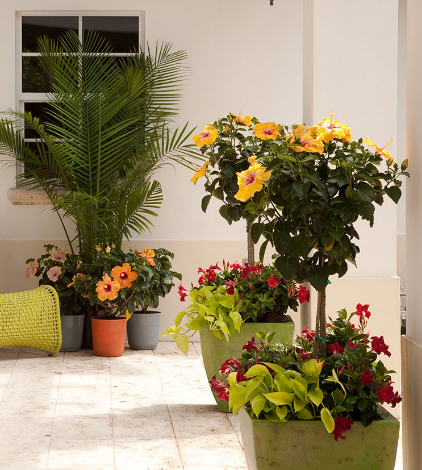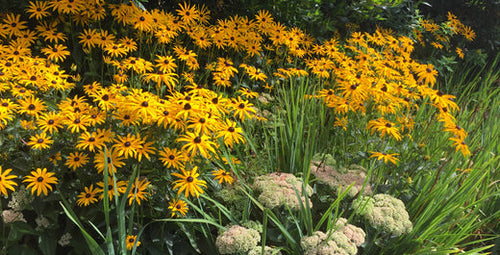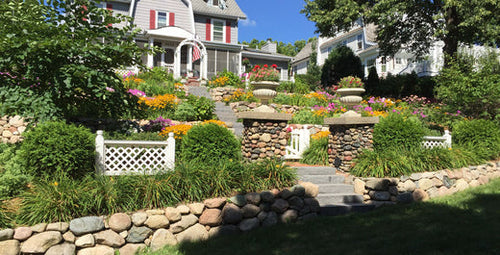By Karen Weir-Jimerson
You’ve made the plunge and purchased your first home! Kudos to you. Once you’ve cleaned, painted, decorated and made the interior your own, it’s time to turn your energies to your yard. Tackling outdoor yard projects can be daunting, especially if you worry that you might have a black thumb under those brand new garden gloves. But no worries. Here are 9 things you can do to transform your new yard.

1. Divide and conquer.
Most homes have four areas around the house: a front, a back, and two side yards. So where do you start? If you want to impress your new neighbors, start with the front. It’s called curb appeal—improvements that you see from the street that make your house more appealing (and even worth more!). If you want to carve out a little hangout for yourself, start in the back where you’ll have more privacy while having a drink or grilling a burger. But remember: It's your perfect yard. Start with the spaces that matter the most to you.

2. Neaten up.
Mow, blow, trim. Just nipping and tucking your yard will make it more beautiful. You don’t need to have the best lawn in the neighborhood, but it should be neat. Even a weedy lawn looks better after it is mowed, edged, and the grassy debris collected. Use a lawn blower to clear sidewalks. Rake up excess leaves. Remove any dead limbs or branches in trees and shrubs; this will immediately make them look healthier and happier.
3. Determine outdoor space use.
How you want to use your yard will help determine where you want to spend your bucks. Do want an area to entertain friends, a garden to raise herbs and veggies for more healthful lifestyle, or enjoy a cut-flower garden? Make a list of yard uses and rate them. Then start with item one on the list.
4. Create a plan.
A landscape plan is your best friend when it comes to redoing your yard. Hire a landscape architect to do a drawing of your lot or you can DIY it by walking through your neighborhood and copying some of the outdoor improvements your neighbors have made. (You’ll also see what plants excel in your area.) Some landscaping projects (such as adding a patio or deck) can be pricey, so executing your landscape plan over time allows you to amortize the cost over several years.

5. Plan for low-maintenance.
If you work long hours or travel for business, an easy-care landscape will make you love your yard (not feel enslaved by it). If you don’t relish mowing, lessen your lawn area with a patio or garden bed. If you don’t have time to water, install a drip irrigation system that waters even when you aren’t home (you can even put drip emitters into pots!). If you want a veggie garden, plant in raised beds because they are easier to plant in and harvest from. Use mulch around all trees, shrubs, and plants (even in containers) to help conserve soil moisture, eliminate weeding chores, and make your landscape look neater.
Get more tips to keep your yard weed free.
6. Choose a color scheme.
Even if you don’t have a lot of outdoor accessories, you can make them feel connected to each other by sticking with a color theme. If you love red, pop some geraniums into terra-cotta pots on your patio. Buy a pair of cobalt blue containers and add a pair of eugenia topiaries to flank your front door. You can express your color style with the containers and flower and foliage colors.
Get ideas for creating your own colorful container gardens.
7. Infuse floral color.
The fastest and most inexpensive way to dress up your yard is with colorful flowers. Annuals such as geraniums, petunias, and marigolds come in bloom in garden centers and stay colorful all season until frost (then they die). You can buy them in quantity (in flats or 6-or 8-packs) and plant them; they look stunning the minute you place them in soil. Line your front walk. Pack annuals into big containers flanking your front door. Tuck them into the landscaping around trees and shrubs. There are annuals that love sun and those that love shade. Get the right kind for your landscape. Check the plant tag for light requirements before you buy.

8. Create a focal point.
You can enjoy the view outdoors from indoors. This is especially important in climates where you can’t spend year round in the garden. Place a bench as a visual destination. Add a piece of art, such as a bottle tree. Use a container packed with flowers, a small shrub, or a small tree. Add a birdbath or bird feeding station. A focal point in your yard also gives you something to enjoy from inside your house.
9. Make small gardens.
You don’t need a lot of land for a beautiful yard. Make small gardens such as window boxes, patio containers, hanging baskets, or tabletop cactus or terrarium gardens add life and color to your outdoor spaces.
















